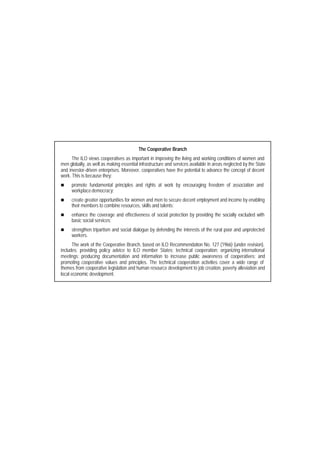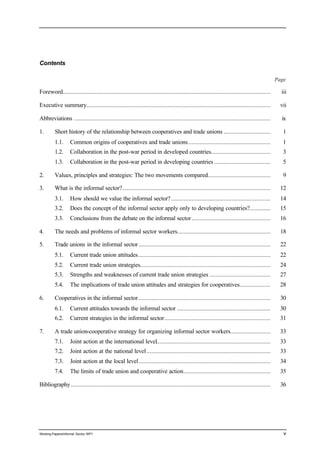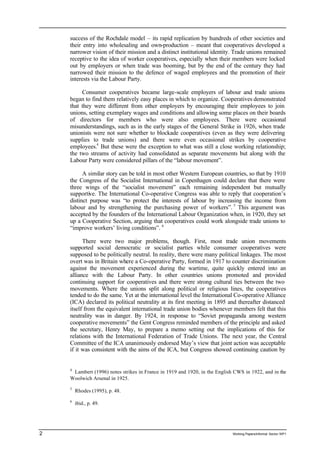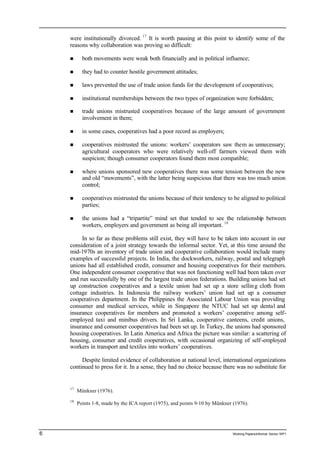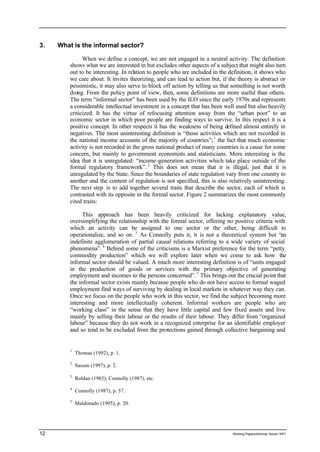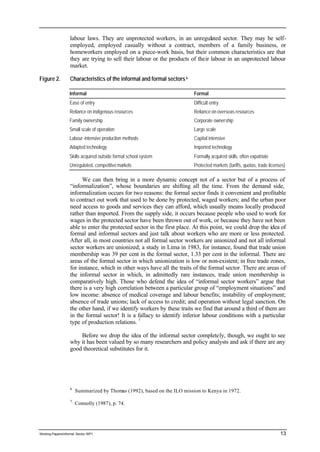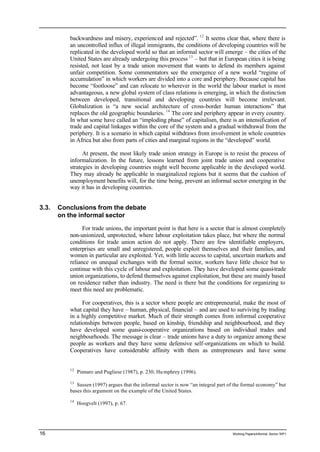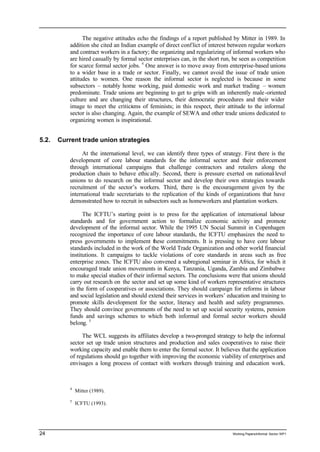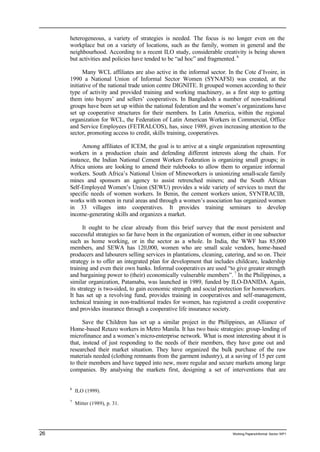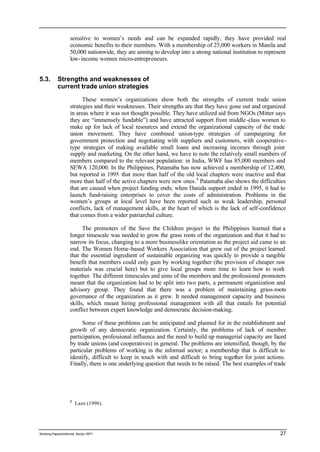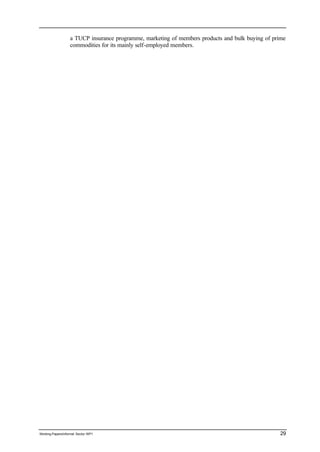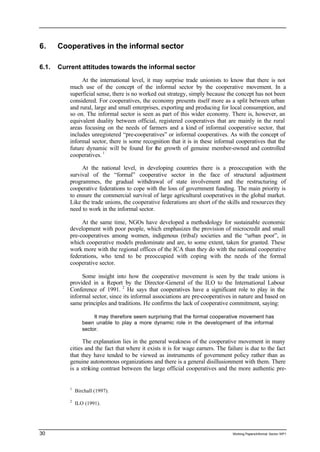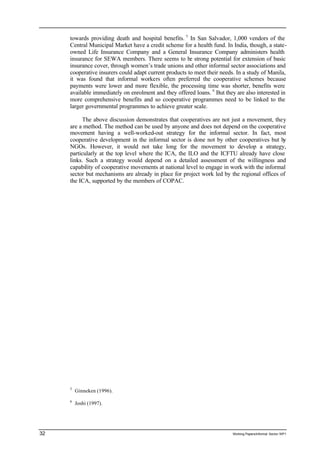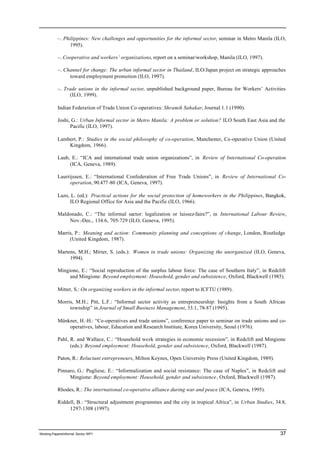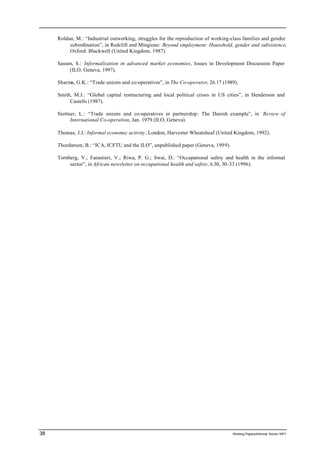Wcms 110508
- 1. Coop Working Paper 01-1 Organizing workers in the informal sector A strategy for trade union-cooperative action by Dr. Johnston Birchall Cooperative Branch International Labour Office
- 3. The Cooperative Branch The ILO views cooperatives as important in improving the living and working conditions of women and men globally, as well as making essential infrastructure and services available in areas neglected by the State and investor-driven enterprises. Moreover, cooperatives have the potential to advance the concept of decent work. This is because they: n promote fundamental principles and rights at work by encouraging freedom of association and workplace democracy; n create greater opportunities for women and men to secure decent employment and income by enabling their members to combine resources, skills and talents; n enhance the coverage and effectiveness of social protection by providing the socially excluded with basic social services; n strengthen tripartism and social dialogue by defending the interests of the rural poor and unprotected workers. The work of the Cooperative Branch, based on ILO Recommendation No. 127 (1966) (under revision), includes: providing policy advice to ILO member States; technical cooperation; organizing international meetings; producing documentation and information to increase public awareness of cooperatives; and promoting cooperative values and principles. The technical cooperation activities cover a wide range of themes from cooperative legislation and human resource development to job creation, poverty alleviation and local economic development.
- 4. Contents Page Foreword................................................................................................................................. iii Executive summary.................................................................................................................. vii Abbreviations .......................................................................................................................... ix 1. Short history of the relationship between cooperatives and trade unions ............................. 1 1.1. Common origins of cooperatives and trade unions ................................................... 1 1.2. Collaboration in the post-war period in developed countries..................................... 3 1.3. Collaboration in the post-war period in developing countries ................................... 5 2. Values, principles and strategies: The two movements compared....................................... 9 3. What is the informal sector?............................................................................................ 12 3.1. How should we value the informal sector?.............................................................. 14 3.2. Does the concept of the informal sector apply only to developing countries?............. 15 3.3. Conclusions from the debate on the informal sector ................................................. 16 4. The needs and problems of informal sector workers.......................................................... 18 5. Trade unions in the informal sector .................................................................................. 22 5.1. Current trade union attitudes .................................................................................. 22 5.2. Current trade union strategies................................................................................. 24 5.3. Strengths and weaknesses of current trade union strategies ...................................... 27 5.4. The implications of trade union attitudes and strategies for cooperatives................... 28 6. Cooperatives in the informal sector .................................................................................. 30 6.1. Current attitudes towards the informal sector .......................................................... 30 6.2. Current strategies in the informal sector.................................................................. 31 7. A trade union-cooperative strategy for organizing informal sector workers......................... 33 7.1. Joint action at the international level....................................................................... 33 7.2. Joint action at the national level ............................................................................. 33 7.3. Joint action at the local level.................................................................................. 34 7.4. The limits of trade union and cooperative action...................................................... 35 Bibliography ............................................................................................................................ 36 Working Papers/informal Sector WP1 v
- 5. vi Working Papers/informal Sector WP1
- 6. Executive summary Section 1 describes the common origins of trade unions and cooperatives in the early period of industrialization, when organizational boundaries were fluid and working people, whose situation was not unlike those of informal sector workers today, designed local associations with the purpose both of strengthening the market position of artisans and providing them with essential consumer goods. Quite quickly the two strategies solidified of trade unionism and consumer cooperation, and the growth of the two movements, led to their having to be formally linked as “twin pillars” of the labour movement. The broadening out of the cooperative movement to include credit, agricultural and worker cooperatives complicated matters, as did the close alliance of unions with political parties, but the International Co-operative Alliance managed to resist pressures from some of its members for a strict definition of “political neutrality” and to continue to collaborate in an ad hoc way with the International Federation of Trade Unions. During the post-war period trading difficulties encountered by consumer cooperatives and then an intense debate about the merits of worker takeovers of failing enterprises, dominated the agenda in developed countries. In developing countries, both movements were well aware of the need to collaborate on development issues, but neither had the organizational capacity to fulfil their aspirations. By the 1980s this desire to collaborate began to be expressed in terms of the informal sector and in virtually all countries some development of cooperatives among informal sector workers by trade unions or the established cooperative movement had been undertaken. However, in relation to the size of the problems informal sector workers face, and the urgency of their needs, results so far have been modest. Section 2 provides a brief analysis of the values and principles held by the two movements. It identifies “first order” values in liberty, equality and solidarity, and second order values in democracy, mutual help and mutual struggle, and shows how cooperatives and trade unions share core values, but express them through different strategies. This means that more emphasis is placed by unions on mutual struggle, by cooperatives on mutual help, but that in their operating principles again they share a common heritage of voluntary and open membership and a desire to share the results of their activities with people as members rather than as contributors of capital. These similarities can be overlooked when cooperatives themselves become large-scale employers of labour and unions have to organize workers within them or, in the special case of workers’ cooperatives, when unions promote a completely different form of workers’ emancipation. They each bring to the informal sector a set of strengths that are wide ranging and complementary. Section 3 asks what is the informal sector. It explores some of the strengths and weaknesses of the concept and finds that it becomes more useful when we concentrate on the workers and on the process of informalization, rather than on the attributes of a sector. The key points are that its workers are unprotected and unorganized. The question is then asked how we should value the informal sector and the paper notes widely differing viewpoints that range from overly optimistic to pessimistic. It asks whether the concept is as applicable in developed countries and concludes that, though informalization processes are going on, they are not as pervasive as in developing countries and so a trade union strategy to try to resist informalization and to reformalize enterprises is more feasible. The conclusion is that, from their different points of view, unions and cooperatives have a duty to work among informal sector workers and have particular affinities with them: the one with the workers as exploited and unprotected; the other with the workers as entrepreneurs dealing as best they can in a competitive market. Section 4 investigates the needs and problems of informal sector workers, finding that their classification into owners, own-account workers and dependent workers is most useful. The situation they face can be described as the lack of a whole series of essentials Working Papers/informal Sector WP1 vii
- 7. and the facing of a series of constraints. The situation of women is noted as being particularly hard in all these respects. The common theme is vulnerability. The discussion then focuses on the capacity of informal sector workers to overcome these lacks and constraints through self-organization. The known strengths and weaknesses of their associations are identified. The conclusion is that unions and cooperatives can bolster these associations through community development techniques and that, while both can work well together, unions might have advantages in organizing dependent workers and cooperatives in developing associations of the self-employed. Section 5 examines trade union attitudes to informal sector workers, showing that while it is a major priority at the international level, at the national level attitudes are still ambivalent and sometimes negative. When they have reservations, union activists point to potential conflicts of interest between formal and informal sector workers and to the operational difficulties in organizing in the informal sector. Current strategies at the international level include the development of core labour standards and their enforcement, pressure on national unions to develop strategies towards the sector and encouragement of the replication of successful models of trade union organizing among homeworkers, plantation workers and so on. The strengths of current strategies are shown by some women’s trade unions that have managed to organize among homeworkers. However, analysis of their record shows that as they grow these kinds of unions need to deal with problems of managerial and organizational capacity and a need to ensure continuing democratic accountability. The question is asked whether unions and cooperatives need to be backed by a social movement such as nationalism or feminism, in order really to take off into sustained growth. Section 6 attempts to identify cooperative attitudes to the informal sector and finds that the concept has not been much used. This is because the boundaries between formal and informal are not as important to organizations that are used to dealing in the market economy as a whole. There is a parallel concern with a “formal” cooperative sector that is currently undergoing restructuring and retrenchment under the impact of structural adjustment and progressive withdrawal of government involvement and an “informal” sector of informal cooperatives and pre-cooperatives that show great vibrancy and potential for growth. Strategies specifically for the informal sector still need to be developed, but it is expected that at the international level the movement can respond quickly to the need to develop a joint strategy with the trade union movement. The known strengths and weaknesses of different types of cooperative are considered for their relevance to such a strategy, and it is concluded that credit and insurance cooperatives and trade-based supply and marketing cooperatives have the most potential. Section 7 proposes a joint strategy. At the international level, there is a need for a statement of common intent by the ICA and ICFTU. The linking of specialist organizations of the ICA and the international trade secretariats of the ICFTU would enable an inventory to be made of the specialist skills available. Regional seminars might then lead to a series of local demonstration projects, organized by the regional offices of the ILO, ICA and ICFTU, in conjunction with national-level federations. At the local level it is proposed that up to four models be considered for joint working: a local resource centre staffed by experts from both unions and cooperatives, a development agency working with community groups, a similar agency working with associations of trades people and specialized trade unions that can organize among distinct subsectors such as women homeworkers, supported by teams of cooperative developers. Finally, the limits of joint action are identified, in issues such as social security, health and safety and provision of land rights and infrastructure, where unions and cooperatives can be pressure groups, channels, facilitators, but where success depends on the coordinated efforts of a range of other agencies such as local governments, health workers, employer organizations and NGOs. viii Working Papers/informal Sector WP1
- 8. Abbreviations COPAC Committee for the Promotion and Advancement of Cooperatives DANIDA Danish Agency for Development Assistance DIGNITE Confédération des syndicats libres de Côte d’Ivoire FAO Food and Agricultural Organization FENALTHYS Federación Nacional de Trabajadores de las Industrias del Turismo- Hotelero, de la Alimentación, las Bebidas y Similares de Colombia FETRALCOS Federación Latinoamericana de Trabajadores del Comercio ICA International Co-operative Alliance ICEM International Federation of Chemical, Energy, Mine and General Workers’ Unions ICFTU International Confederation of Free Trade Unions IFBWW International Federation of Building and Wood Workers IFPAAW International Federation of Plantation, Agricultural and Allied Workers IFTU International Federation of Trade Unions ILO International Labour Organization ITGLWF International Federation of Textile, Garment and Leather Workers’ Federation IUF International Union of Food, Agricultural, Hotel, Restaurant, Catering, Tobacco and Allied Workers’ Associations LEAD-CO Labor Education for Assistance and Development-TUCP NGO Non-governmental organization SEWA Self-Employed Women’s Association SEWU Self-Employed Women’s Union SINTRAINAGRO Sindicato Nacional de la Industria Agropecuaria de Colombia SNTUC Singapore National Trades Union Congress SYNAFSI Syndicat National des Femmes du Secteur Informel TUCP Trade Union Congress of the Philippines UN United Nations WCL World Confederation of Labour WFTU World Federation of Trade Unions Working Papers/informal Sector WP1 ix
- 10. 1. Short history of the relationship between cooperatives and trade unions 1.1. Common origins of cooperatives and trade unions Cooperatives and trade unions are modern institutions, the products of an industrial revolution that radically altered the terms under whic h people laboured in order to earn their subsistence and that necessitated new forms of self-protection for the emerging working classes. 1 In Britain, where industrialization began earliest, they both trace their origins to an earlier form of working class mutual aid, the friendly society, a simple mutual insurance club invented to cope with the risks working people faced in an uncertain world where the idea of state -sponsored social security still had to be invented. With hindsight, we can say confidently that the first cooperative movement began in Brighton, England, in 1827, but when William Bryan and Dr. King set up their shop they could not have said whether their new venture was a cooperative or a trade union; in fact, they would probably not have understood the question. Their “Brighton Co-operative Trading Association” was a cooperative, a term already being used to describe mutual trading, but it was also an association of people who belonged to trade associations with names such as the “Boot and Shoe Makers Society”, the “Society of Tailors” and the “Hearts of Oak Society of Carpenters”. These trade societies were as much descendants of the medieval guilds as they were the ancestors of the modern trade unions; skilled workers were still mainly self-employed, working in small workshops and selling their services and products to a main contractor or directly to a final customer. At that time, the term “union” was used to describe “almost any sort of working class movement animated by a socialist ideal; 2 there could be unions for cooperative production, unions for political reform and “union shops”. The Brighton shop was one of these, having the dual purpose of bulk purchasing of essentials such as flour, oatmeal and candles and sale of goods made by its members. It was a blend of what we would call consumer and worker cooperation. 3 At the same time, trade unionism of the sort we recognize today was emerging in such trades as the building and the cotton industries, with national-level unions being formed, such as the Grand General Union of Cotton Spinners. Not long after the Brighton shop opened, Robert Owen was attempting to weld these into one “Grand National Consolidated Union” that would use the general strike as a weapon to achieve political rights. By the time the Rochdale Pioneers opened their famous “Toad Lane” store in 1844, they were conscious that there was a range of strategies for defending the living standards of working people: local and general strikes to keep up wages, political agitation for the vote, reform movements for labour protection, cooperative stores, worker co-production, and so on. The weavers who met to decide what to do next when a recent strike had failed might equally have set up their own workshop, or continued with their political organizing for a democratic “charter”, but they chose to put their tiny resources into opening a store. From then on, we can see how trade unionism and cooperation began to part company. The 1 Birchall (1994). 2 Cole (1994), p. 24. 3 Birchall (1994). Working Papers/informal Sector WP1 1
- 11. success of the Rochdale model – its rapid replication by hundreds of other societies and their entry into wholesaling and own-production – meant that cooperatives developed a narrower vision of their mission and a distinct institutional identity. Trade unions remained receptive to the idea of worker cooperatives, especially when their members were locked out by employers or when trade was booming, but by the end of the century they had narrowed their mission to the defence of waged employees and the promotion of their interests via the Labour Party. Consumer cooperatives became large-scale employers of labour and trade unions began to find them relatively easy places in which to organize. Cooperatives demonstrated that they were different from other employers by encouraging their employees to join unions, setting exemplary wages and conditions and allowing some places on their boards of directors for members who were also employees. There were occasional misunderstandings, such as in the early stages of the General Strike in 1926, when trade unionists were not sure whether to blockade cooperatives (even as they were delivering supplies to trade unions) and there were even occasional strikes by cooperative employees.4 But these were the exception to what was still a close working relationship; the two streams of activity had consolidated as separate movements but along with the Labour Party were considered pillars of the “labour movement”. A similar story can be told in most other Western European countries, so that by 1910 the Congress of the Socialist International in Copenhagen could declare that there were three wings of the “socialist movement” each remaining independent but mutually supportive. The International Co-operative Congress was able to reply that cooperation’s distinct purpose was “to protect the interests of labour by increasing the income from labour and by strengthening the purchasing power of workers”. 5 This argument was accepted by the founders of the International Labour Organization when, in 1920, they set up a Cooperative Section, arguing that cooperatives could work alongside trade unions to “improve workers’ living conditions”. 6 There were two major problems, though. First, most trade union movements supported social democratic or socialist parties while consumer cooperatives were supposed to be politically neutral. In reality, there were many political linkages. The most overt was in Britain where a Co-operative Party, formed in 1917 to counter discrimination against the movement experienced during the wartime, quite quickly entered into an alliance with the Labour Party. In other countries unions promoted and provided continuing support for cooperatives and there were strong cultural ties between the two movements. Where the unions split along political or religious lines, the cooperatives tended to do the same. Yet at the international level the International Co-operative Alliance (ICA) declared its political neutrality at its first meeting in 1895 and thereafter distanced itself from the equivalent international trade union bodies whenever members felt that this neutrality was in danger. By 1924, in response to “Soviet propaganda among western cooperative movements” the Gent Congress reminded members of the principle and asked the secretary, Henry May, to prepare a memo setting out the implications of this for relations with the International Federation of Trade Unions. The next year, the Central Committee of the ICA unanimously endorsed May’s view that joint action was acceptable if it was consistent with the aims of the ICA, but Congress showed continuing caution by 4 Lambert (1996) notes strikes in France in 1919 and 1920, in the English CWS in 1922, and in the Woolwich Arsenal in 1925. 5 Rhodes (1995), p. 48. 6 ibid., p. 49. 2 Working Papers/informal Sector WP1
- 12. approving joint action only “in such specific matters as may arise from time to time, and subject to each question being previously submitted to and approved by the Central Committee”. During the inter-war period, then, the ICA and IFTU did manage to work together on an “ad hoc” basis. 7 The second problem was that the cooperative movement did not just consist of consumer cooperatives. In Germany, self-employed artisans and small traders in the towns, and small farmers in the rural areas, established a different kind of cooperation, based on credit banking. 8 In Denmark, farmers developed the agricultural cooperative for supply, marketing and processing of farm products. In France and Italy, the workers’ cooperative was promoted as a way of emancipating labour altogether from the employee-employer relationship. All of these models spread, more or less rapidly, from country to country and their relationship with the trade unions was much less close than that of the consumer cooperatives. The Raiffeisen cooperative banking movement withdrew from membership of the ICA in 1904 but other movements continued membership and, though the Alliance was dominated by the consumer cooperatives, it had to represent the interests of other cooperative movements that objected to being aligned too closely with the labour movement. 1.2. Collaboration in the post-war period in developed countries After the Second World War and the onset of the “cold war”, political strains within the ICA intensified and there was a continuous struggle to keep the Alliance from fracturing. The trade union movement did divide into two – the International Confederation of Free Trade Unions (ICFTU) and the World Federation of Trade Unions (WFTU). The ICA managed to maintain relationships with both of them. National-level organizations also met regularly, at least in Western European countries, but the judgement of one commentator writing in the early 1960s was that “even where these contacts exist, collaboration could be closer, more decisive and more constant”. 9 By this time, the consumer cooperative movements of most Western European countries were beginning to encounter serious competition from multiple traders and began a long and painful process of consolidation and centralization of their operations. The atrophying of their democratic base of customer-members was both a cause of their difficulties and a consequence of the attempts to restructure. For trade unionists the “Co-op” became irrelevant, almost ceasing to exist in their consciousness as part of the labour movement. At national level, unions continued to give support, sometimes becoming embroiled in the financial affairs of the cooperatives: in Germany, the unions managed to sell their shares in Co-op AG (which had converted to a shareholding company) before it went bankrupt. Cooperatives declined fastest in those areas (such as Northern France) 7 Minutes of the Central Committee of the ICA, 6 Oct. 1925. Some Scandinavian members wanted to keep the ICA to a much narrower role. May argued that article 4f of the ICA statutes on “s pecial collaboration with other international organizations pursuing aims of importance to cooperation”, licensed “neutral joint action” with the IFTU. He identified as acceptable subjects the prevention of strikes among cooperative employees, promotion of universal peace, and evolution of international fiscal policy. 8 Birchall (1997). 9 Lambert (1996), p. 199. Working Papers/informal Sector WP1 3
- 13. where they were most bound up with an industrial working class culture that was also finding it hard to adapt to large-scale economic change. 10 Two exceptions to this picture were Israel, where cooperatives and trade unions continued to maintain very close links and Denmark, where the unions had a long tradition of financing workers’ productive enterprises. 11 Then, with the shock to the economic system of the western economies caused by the 1973 oil price rise, trade unions in several countries began to take an interest in worker rescues of firms threatened with closure. Within a decade, around 1,000 worker takeovers had been achieved in Italy, 1,300 in Spain and around 200 in Britain. In France, expansion in this area was initially delayed by trade union attitudes and in West Germany again unions remained reluctant to support the new workers’ cooperatives. It is worth identifying reasons why there was such suspicion among some trade unionists, in case similar attitudes affect collaboration between the two movements in the informal sector: n there was suspicion that, in order to survive in the market, cooperatives might pay low wages and worse terms and conditions; n they might undercut prices in conventional firms, thus putting more jobs at risk; n only some of the jobs threatened by firm closures would be saved; n development of cooperatives was an unfamiliar strategy, demanding new skills of trade unionists in business planning and marketing; n cooperatives undermined collective bargaining, by taking workers out of the employee-employer relationship; n for Marxists they were a diversion from class struggle, splitting class interests. 12 Researchers at the time felt that this critique was overstated, though it pointed to some genuine difficulties in the relationship that cooperatives had to be aware of and to overcome. In Italy, there were no such reservations on the part of trade unionists. Holmstrom reports that in the large cooperatives almost all members belonged to a union, even those who as board members or managers had a different “class interest”. In the Emilia-Romagna region there was a high concentration of both worker cooperatives and union membership; both types of workers’ organization shared a common culture. They were helped by the decentralization of collective bargaining in the 1970s when works councils became part of the structure of the cooperatives. 13 Yet in the Mondragon cooperatives in the Basque region of Spain the absence of unions was not felt as a disadvantage, rather the cooperatives’ own structures were felt to be adequate in protecting the interests of members. Towards the end of the 1980s when, with more stable economic conditions, the rate of cooperative rescues had slowed and the fall of communist regimes had taken much of the ideological heat out of the debate, it began to be recognized that workers’ cooperatives 10 Brazda and Schediwy (1998). 11 For Denmark, see Stettner (1979). 12 Paton et al (1989). 13 Holmstrom. 4 Working Papers/informal Sector WP1
- 14. and trade unions were simply different ways of emancipating labour. A “new unionism” began to emerge that emphasized not only collective bargaining but services to members and the Western European unions became interested in what is perhaps the most complementary and easily organized of cooperatives for union members – credit unions. These have become the fastest growing part of the cooperative movement and it is the workplace-based credit unions that are the strongest. 1.3. Collaboration in the post-war period in developing countries In developing countries, meanwhile, there were calls from all sides for collaboration between the two movements. In 1966, in Malaysia the first of many seminars was held on trade unionism and cooperation, focusing on the potential synergy to be gained from their collaborating in development. In the same year, the International Labour Office (ILO) became involved, with an international labour conference on the role of cooperatives in development that encouraged workers’ organizations to help in the implementation of plans. The ILO continued with an interregional meeting to highlight the complementary role of trade unions and cooperatives and this was followed by a series of regional and national seminars in Nairobi, Singapore, Ankara and Guyana. In 1970 the ICFTU Round Table on Trade Unions in Asia emphasized cooperative development within unions, suggesting they promote credit unions, producer and consumer cooperatives on behalf of union members. A panel of experts organized by the ICFTU recommended for rural India the setting up of multi-purpose cooperatives functioning as both unions and cooperatives. By 1971, the World Conference of the ICFTU was calling for the trade union movement to broaden its base in rural areas by developing cooperatives and, when a Committee for the Promotion and Advancement of Cooperatives was formed (COPAC), one of the ICFTU’s sectoral organizations – the International Federation of Plantation, Agricultural and Allied Workers – became a member, along with the ICA, the ILO, the Food and Agriculture Organization (FAO) and the Social Development Division of the United Nations. In 1972 the 25th Congress of the ICA in Warsaw adopted a resolution on “Unified action of cooperatives and trade union movements” proposed by members from Eastern Europe and the USSR, which was agreed practically without discussion. It stated that the two movements were “united by a unity of purpose which opens wide possibilities for a comprehensive collaboration between them”, which was to be directed at improving the standard of living of the “broad masses of the working people”. 14 Speaking to the ICA, the General Secretary of the ICFTU put great stress on collaboration with the cooperative movement, saying “there is clearly a need for an ever closer coordination of their efforts and our own in the developing regions. 15 These top-level commitments were slow to translate into action on the ground. An ICA report in 1975 found that “In no developing country have trade unions or cooperatives as yet made a concerted effort to coordinate their activities”. 16 An expert report of the same period found that there was little organized collaboration and the two movements 14 Rhodes (1995), p. 464. 15 ICA (1975), p. 4. 16 ICA (1975), p. 8. The exception cited was Colombia, where the national trade union council set up a cooperative department as early as 1957. Working Papers/informal Sector WP1 5
- 15. were institutionally divorced. 17 It is worth pausing at this point to identify some of the reasons why collaboration was proving so difficult: n both movements were weak both financially and in political influence; n they had to counter hostile government attitudes; n laws prevented the use of trade union funds for the development of cooperatives; n institutional memberships between the two types of organization were forbidden; n trade unions mistrusted cooperatives because of the large amount of government involvement in them; n in some cases, cooperatives had a poor record as employers; n cooperatives mistrusted the unions: workers’ cooperators saw them as unnecessary; agricultural cooperators who were relatively well-off farmers viewed them with suspicion; though consumer cooperators found them most compatible; n where unions sponsored new cooperatives there was some tension between the new and old “movements”, with the latter being suspicious that there was too much union control; n cooperatives mistrusted the unions because of their tendency to be aligned to political parties; n the unions had a “tripartite” mind set that tended to see the relationship between workers, employers and government as being all important. 18 In so far as these problems still exist, they will have to be taken into account in our consideration of a joint strategy towards the informal sector. Yet, at this time around the mid-1970s an inventory of trade union and cooperative collaboration would include many examples of successful projects. In India, the dockworkers, railway, postal and telegraph unions had all established credit, consumer and housing cooperatives for their members. One independent consumer cooperative that was not functioning well had been taken over and run successfully by one of the largest trade union federations. Building unions had set up construction cooperatives and a textile union had set up a store sellin g cloth from cottage industries. In Indonesia the railway workers’ union had set up a consumer cooperatives department. In the Philippines the Associated Labour Union was providing consumer and medical services, while in Singapore the NTUC had set up dental and insurance cooperatives for members and promoted a workers’ cooperative among self-employed taxi and minibus drivers. In Sri Lanka, cooperative canteens, credit unions, insurance and consumer cooperatives had been set up. In Turkey, the unions had sponsored housing cooperatives. In Latin America and Africa the picture was similar: a scattering of housing, consumer and credit cooperatives, with occasional organizing of self-employed workers in transport and textiles into workers’ cooperatives. Despite limited evidence of collaboration at national level, international organizations continued to press for it. In a sense, they had no choice because there was no substitute for 17 Münkner (1976). 18 Points 1-8, made by the ICA report (1975), and points 9-10 by Münkner (1976). 6 Working Papers/informal Sector WP1
- 16. such action, no obvious alternative strategy for each of the two movements if they wanted to have an impact on the lives of the poor. As the ICA report put it: Little has been attempted so far but, in view of the urgency of the problem regarding the general economic situation in developing countries, such action should not be delayed for too long. 19 Pressure was kept up by the trade union side. In 1983 the All India TUC called for organizing the “unorganized” to be made a priority, complaining that there had been few achievements on record. In 1988 the term “informal sector” began to be used. The World Congress of the ICFTU noted the growth of this sector during the 1980s and called on national centres to make it a priority. A report commissioned to follow this Congress found that “the crucial task facing the labour movement” was “to reorientate the mode of mobilization and to redefine the concept of worker”. 20 In reviewing trade union action in the informal sector, it found that “grass-roots projects have the best chance of success where a combination of trade union and cooperative activities is judiciously applied”. 21 Action does seem to have been slow in coming, for in 1989 a report from an eminent Indian cooperator complained that close collaboration was still the exception and that, despite continuing international seminars, there had been no real dia logue between the two movements and even still some mistrust. 22 In that same year two important reports were published, both recommending that collaboration be aimed particularly at the informal sector, where the poor economic conditions and exploitation of labour were a challenge to both movements. The reports recommended the following actions: n the ICA and ICFTU should have a common strategic approach to working with the ILO and other UN agencies; n they should develop common policies in areas of joint concern such as the labour movements of third world countries and in utilizing the expertise of the ICA’s specialist organizations; n there was a key role for COPAC in developing this new phase in cooperative and trade union relations. 23 Work on the informal sector continued, with the ILO taking the lead in convening subregional seminars and then in 1994 setting up an interdepartmental action-research project that considerably expanded our knowledge of how to develop a comprehensive strategy towards the informal sector. 24 What is surprising about this debate is the lack of any contribution from the cooperative side. The ICFTU and the ILO have continued to push for action; yet since the report in 1975 the ICA seems to have been preoccupie d with other issues. In the early 1980s it went through a painful restructuring process and then began to concentrate on the 19 ICA (1975), p. 23. 20 Mitter (1989), p. 7. 21 ibid., p. 35. 22 Sharma (1989). 23 Laub (1989) and ICFTU (1989). 24 ILO (1994 and 1995). Working Papers/informal Sector WP1 7
- 17. major task of updating cooperative values and principles, but it has also had a continuing involvement with cooperative movements in developing countries. 25 It has been concerned with the impact of structural adjustment, the drafting of new cooperative laws in Africa and Eastern Europe, and with the development of informal or pre-cooperatives among poorer people and particularly among women, but its concern seems not to have been expressed in terms of the informal sector. This means that much work needs to be done in putting the question of collaboration in this sector on the cooperative agenda. However, the two movements have continued their “ad hoc” colla boration. In 1997 Eddy Laurijssen, the Assistant General Secretary of the ICFTU, addressed the World Assembly of the ICA, noting that the underlying aims of the two movements were the same, but suggesting that they still had to consider the coordination of strategies. The backing of the trade unions within the ILO for the revision of Recommendation No. 127 on cooperative development has been an important demonstration of solidarity and it should lead to greater collaboration between the two movements in the process of its revision. Likewise, the endorsement by the ICA Board in April 1999 of the ILO Declaration on Fundamental Principles and Rights at Work is an important statement of intent and could contribute significantly to the continued dialogue between the movements. However, one cannot help hearing in Laurijssen’s words echoes of similar sentiments expressed many times over the last few decades and there are still important questions to be asked about how such collaboration can be sustained. A focus on the needs of workers in the informal sector of developing countries may be one answer, though this raises a whole new set of questions. Before we turn to these, however, it may be useful to examine in more depth the values and principles on which each movement is based, in order to find out if there really is an underlying solidarity on which collaborative strategies can be based. 25 Birchall (1997a), Ch. 2. 8 Working Papers/informal Sector WP1
- 18. 2. Values, principles and strategies: The two movements compared Values are deeply held beliefs about what is important. They give us the energy we need in order to act, give direction to our work and help determine our priorities. If we know what values people hold we can compare these with our own and determine whether or not we can work together. What is true of individuals is also true of social movements; values are held in common, help to provide a sense of common purpose and help to distinguish one movement from another. There are two kinds of values. We might call them “first order” and “second order” values, the distinction being between values that are ends in themselves and those that are a means to an end. 1 The trilogy of liberty, equality and fraternity (the last better referred to in non-sexist language as solidarity or community) are generally considered to be ends; they are a means to the good life (what Aristotle called “eudaemonic”), but in western liberal thought it is assumed that, because individuals do not necessarily agree on what this good life consists of, we should stop short at specifying any more closely what it might be and consider the various combinations of liberty, equality and solidarity that provide the best conditions for it. Political philosophers disagree over definitions of liberty and equality and tend to value one higher than the other, recognizing that both cannot be maximized and that at some point a trade-off has to be made between them. Solidarity is important because the extent and nature of the ties that bind people to each other will tend to determine how much inequality they will tolerate, how much liberty they are prepared to allow to others, and so on. Second order values that are relevant to this discussion include democracy, mutual help and mutual struggle . Democracy is a means of making decisions which allows for formal equality (one person one vote, and all votes counting equally), as a compensation for joint decision-making which inevitably takes away people’s liberty through enforcement of majority decisions. Mutual help expresses the reality that people who do not have enough resources to maximize their own liberty can work together to create resources that they would not have been able to create on their own. Mutual struggle expresses the reality that less advantaged people will experience opposition to their search for the good life by restrictions put on their liberty by others who are more powerful than they are and that again the only way to overcome this is through mutual cooperation. Together, these values lead to operating principles expressed in the organizations people create, principles such as voluntariness, fair-sharing in the results of joint action, open membership, and so on. Figure 1. Common values and principles First order values Second order values Operating principles Change strategies Liberty Democracy Voluntariness Economic Equality Mutual help (C) Share in results Political (TU) Solidarity Mutual struggle (TU) Membership-based; open recruitment Cultural (C) We can see how, while they emphasize different aspects of this set of values and principles, cooperatives and trade unions have much in common. They both emphasize the need for equal access to basic resources in order for people to be free from want. Cooperators emphasize equality of opportunity more than equality of condition but 1 Birchall (1997b). Working Papers/informal Sector WP1 9
- 19. acknowledge that without basic equality of condition people cannot begin to meet their needs through mutual help. Trade unionists emphasize equality of condition and use the language of rights rather than of opportunities but it is only a matter of emphasis; there is no basic disagreement over core values. One maximizes liberty by mutual help in joint trading, the other by mutual struggle against those who would appropriate the value created by people’s labour. They use the same kind of associational principles in fashioning their organization but they differ in the strategies they use to express their values; unions, of necessity, use political as well as economic means to achieve their aims, while cooperatives remain economic and cultural institutions. However, we have noted from the brief historical review that these distinctions are not hard and fast; cooperative movements can be politically active and unions can offer cooperative-type services to their members. Both can unite to defend their common interests against forces that would destroy their democratic rights to associate. The differences in strategy are important. Cooperatives create value through joint trading or working together, while trade unions create value through paid work and then extract a proportion of it by negotiation with an employer. Cooperatives are enterprises; unions are mechanisms for collective bargaining. Both want to put capital in its place. Cooperatives acknowledge the need for capital in the creation of value but find ways of rewarding it only as much as is absolutely necessary. Unions also accept the need for capital but, because it is provided by private or public sector owners of capital whose primary purpose is not the benefit of the workers, aim to extract as much of it as they can in an inevitably antagonistic relationship. Cooperatives have a common economic interest against other providers in the market but this is usually a more diffuse kind of antagonism. The logical outcome of cooperative trading is eventually to overcome the antagonism in a completely cooperative economy, while trade unions have no way of overcoming the antagonisms; they have to live with them. Cooperatives, as trading concerns, can be employers of labour and have to negotiate with unions, while unions cannot, by definition, be employers (though they do employ their own staff to a limited extent, who also bargain with their employers). Cooperative members have a complex triple membership as co-owners, users and shareholders, which makes governance of cooperatives challenging. Union members have a simpler relationship to the union, but there are tensions between their affiliation to a trade and to a workplace which also need careful management. Lastly, in most kinds of cooperatives, expanding the membership tends to benefit existing members by lowering prices and trade expenses so it pays them to be politically neutral. In unions, expansion of members is also beneficial as it increases their bargaining power. It also pays them to be politically active so as to win concessions and protection from governments, yet they must not alienate their members in doing so. In sum, the differences between the two movements are real and there are some differences in kind but most are only a matter of degree. They do go some way to explaining the limitations of joint action and help us to understand why collaboration has been relatively weak. A common strategy has to identify areas of common interest and base the relationship on an honest assessment of these interests. Where there is a common commitment to meeting the needs of low-income groups, people who only have their labour to sell (whether as wage earners, contractors or self-employed), they share a set of fundamental core values as a basis for action. This is important when we consider the needs of workers in the informal sector. While the principles and strategies of each movement differ, they can be made complementary. There is a great deal of potential synergy if the strengths of the two can be brought together. Cooperatives have these strengths: 10 Working Papers/informal Sector WP1
- 20. n entrepreneurial and managerial skills; n access to capital; n access to markets (on the enterprise side); n an existing membership base; n access to governments and NGOs; n a track record of concern to alleviate poverty through enterprise. Trade unions have these strengths: n organizing and negotiating skills; n access to labour and employers; n access to governments (labour laws, regulation side); n an existing membership base; n access to a check-off system for member fees; n a track record of concern for workers’ rights, health and safety. If we define trade unions as organizations of workers (regardless of whether they are wage earners) and if we define cooperatives as organizations of working people improving their economic position in the market, we see that there is a great deal of potential synergy in the two approaches. As we shall see below, this is demonstrated by new types of union organization in the informal sector and by informal sector self-help groups which often demonstrate the underlying values, the operating principles and the broad strategies of both movements. Working Papers/informal Sector WP1 11
- 21. 3. What is the informal sector? When we define a concept, we are not engaged in a neutral activity. The definition shows what we are interested in but excludes other aspects of a subject that might also turn out to be interesting. In relation to people who are included in the definition, it shows who we care about. It invites theorizing, and can lead to action but, if the theory is abstract or pessimistic, it may also serve to block off action by telling us that something is not worth doing. From the policy point of view, then, some definitions are more useful than others. The term “informal sector” has been used by the ILO since the early 1970s and represents a considerable intellectual investment in a concept that has been well used but also heavily criticized. It has the virtue of refocusing attention away from the “urban poor” to an economic sector in which poor people are finding ways to survive. In this respect it is a positive concept. In other respects it has the weakness of being defined almost entirely in negatives. The most uninteresting definition is “those activities which are not recorded in the national income accounts of the majority of countries”; 1 the fact that much economic activity is not recorded in the gross national product of many countries is a cause for some concern, but mainly to government economists and statisticians. More interesting is the idea that it is unregulated: “income-generation activities which take place outside of the formal regulatory framework”. 2 This does not mean that it is illegal, just that it is unregulated by the State. Since the boundaries of state regulation vary from one country to another and the content of regulation is not specified, this is also relatively uninteresting. The next step is to add together several traits that describe the sector, each of which is contrasted with its opposite in the formal sector. Figure 2 summarizes the most commonly cited traits: This approach has been heavily criticized for lacking explanatory value, oversimplifying the relationship with the formal sector, offering no positive criteria with which an activity can be assigned to one sector or the other, being difficult to operationalize, and so on. 3 As Connolly puts it, it is not a theoretical system but “an indefinite agglomeration of partial causal relations referring to a wide variety of social phenomena”. 4 Behind some of the criticisms is a Marxist preference for the term “petty commodity production” which we will explore later when we come to ask how the informal sector should be valued. A much more interesting definition is of “units engaged in the production of goods or services with the primary objective of generating employment and incomes to the persons concerned”. 5 This brings out the crucial point that the informal sector exists mainly because people who do not have access to formal waged employment find ways of surviving by dealing in local markets in whatever way they can. Once we focus on the people who work in this sector, we find the subject becoming more interesting and more intellectually coherent. Informal workers are people who are “working class” in the sense that they have little capital and few fixed assets and live mainly by selling their labour or the results of their labour. They differ from “organized labour” because they do not work in a recognized enterprise for an identifiable employer and so tend to be excluded from the protections gained through collective bargaining and 1 Thomas (1992), p. 1. 2 Sassen (1997), p. 2. 3 Roldan (1985); Connolly (1987), etc. 4 Connolly (1987), p. 57. 5 Maldonado (1995), p. 20. 12 Working Papers/informal Sector WP1
- 22. labour laws. They are unprotected workers, in an unregulated sector. They may be self-employed, employed casually without a contract, members of a family business, or homeworkers employed on a piece-work basis, but their common characteristics are that they are trying to sell their labour or the products of their labour in an unprotected labour market. Figure 2. Characteristics of the informal and formal sectors 6 Informal Formal Ease of entry Difficult entry Reliance on indigenous resources Reliance on overseas resources Family ownership Corporate ownership Small scale of operation Large scale Labour-intensive production methods Capital intensive Adapted technology Imported technology Skills acquired outside formal school system Formally acquired skills, often expatriate Unregulated, competitive markets Protected markets (tariffs, quotas, trade licenses) We can then bring in a more dynamic concept not of a sector but of a process of “informalization”, whose boundaries are shifting all the time. From the demand side, informalization occurs for two reasons: the formal sector finds it convenient and profitable to contract out work that used to be done by protected, waged workers; and the urban poor need access to goods and services they can afford, which usually means locally produced rather than imported. From the supply side, it occurs because people who used to work for wages in the protected sector have been thrown out of work, or because they have not been able to enter the protected sector in the first place. At this point, we could drop the idea of formal and informal sectors and just talk about workers who are more or less protected. After all, in most countries not all formal sector workers are unionized and not all informal sector workers are unionized; a study in Lima in 1983, for instance, found that trade union membership was 39 per cent in the formal sector, 1.33 per cent in the informal. There are areas of the formal sector in which unionization is low or non-existent; in free trade zones, for instance, which in other ways have all the traits of the formal sector. There are areas of the informal sector in which, in admittedly rare instances, trade union membership is comparatively high. Those who defend the idea of “informal sector workers” argue that there is a very high correlation between a particular group of “employment situations” and low income: absence of medical coverage and labour benefits; instability of employment; absence of trade unions; lack of access to credit; and operation without legal sanction. On the other hand, if we identify workers by these traits we find that around a third of them are in the formal sector! It is a fallacy to identify inferior labour conditions with a particular type of production relations. 7 Before we drop the idea of the informal sector completely, though, we ought to see why it has been valued by so many researchers and policy analysts and ask if there are any good theoretical substitutes for it. 6 Summarized by Thomas (1992), based on the ILO mission to Kenya in 1972. 7 Connolly (1987), p. 74. Working Papers/informal Sector WP1 13
- 23. 3.1. How should we value the informal sector? The starting point for debate must be a recognition that, whatever the theoretical shortcomings of the concept, the term “informal sector” testifies to a growing phenomenon in the economies of developing countries; outside of the state -regulated, legally recognized, corporate sector there are a growing number of people who work as small-scale producers and providers of services, mainly self-employed or casualized, a high proportion of whom are women and migrants from rural areas. They are based in squatter settlements and on the city streets and use mainly local technologies, using skills gained outside the formal education system, drawing on family, friends and kinship networks in highly informal employment relationships. Their enterprises are largely unrecognized by governments; they tend to avoid most regulatory requirements, are not members of trade unions and do not concern themselves with issues of health and safety. Whether or not the people who work in this way are a “sector”, they are responsible for providing employment for large proportions of the populations of many developing countries. Because of structural adjustment programmes and the inequalities of world trade, the public sector and the corporate private sectors are contracting and shedding labour. We need urgently to learn how to value the “informal” parts of these economies. It is possible to value the “informal sector” in a variety of ways. There is a “new right” view that sees it as an example of entrepreneurship occurring precisely because of the lack of regulation and state interference. In this view, the informality of the sector is its attraction and trade union attempts to organize workers and to regulate and protect labour would be seen as counter-productive. Cooperatives tend, in this view, to be seen as unnecessary because entrepreneurs are motivated by individual incentives, though trade associations that provide training and help with marketing would be welcomed. Needless to say, this viewpoint overlooks the poverty, exploitation and economic marginality of much of this sector. As Riddell points out, the African city seems to be vibrant because of its informal sector but the energy that goes into street trading masks the deep effects of structural adjustment policies that have reduced the formal economy. 8 However, if trade unions were successfully to organize in the informal sector, it is from this libertarian “Utopian” point of view that political opposition can be expected to come. There is an “old left” view that the informal sector is really just “petty commodity production”, a sector that is marginal and will gradually die out as the “modern” sector grows. It emphasizes the underemployment and hidden unemployment within the sector as proof that its workers are a “reserve army of labour”, which competes with and pulls down wages in the formal sector. This viewpoint overlooks the fact that, while some trades such as homeworkers and building subcontractors are linked to the formal sector, much of the informal sector provides a quite separate set of goods and services that would not otherwise be provided. It also overlooks the uncomfortable possibility that, rather than just being a reserve, these workers are actually surplus to requirements; they are a “fourth world” which is simply irrelevant to the workings of the global economy. 9 Nevertheless, to the extent that this “old left” view is still held within trade unions, it may inhibit strategies to organize in the informal sector. There is a “new left” view that sees potential in informal workers as elements of an urban social movement, organizing around neighbourhoods rather than the workplace and campaigning as much for land rights and local government services as for wages and conditions of work. In this view, trade unions and cooperatives are encouraged to work in 8 Riddel (1997). 9 The view of Castells, summarized by Hoogvelt (1997), p. 89. 14 Working Papers/informal Sector WP1
- 24. the informal sector, but they tend to lose their distinctive contribution and are subsumed under this wider strategy of a social movement. Then there is a feminist view that begins from the insight that, in some informal sector occupations such as street vending and home working, the majority of workers are women and that women are disproportionately represented in the sector as a whole. This is explained by reference to the ways in which patriarchal relations within the family interact with economic class doubly to disadvantage women. It leads to a strategy of promoting women’s organizations that contain features of both trade unions and cooperatives and that cuts across the informal and formal distinction to organize women wherever they are exploited: as homeworkers, market traders, domestic workers and workers in free enterprise zones. In India, and parts of Latin America, feminists have been in the forefront of organizing in previously inaccessible parts of the informal sector, around the particular needs of women. At this point it should be possible to construct a theoretical viewpoint that is most favourable to trade union and cooperative intervention in favour of informal sector workers, a view that takes into account the insights of critics as well as supporters of the concept “informal sector”. Before we do this, though, we have to answer a prior question concerning whether the concept – and therefore trade union and cooperative strategies – should apply to both developing and developed countries. 3.2. Does the concept of the informal sector apply only to developing countries? With the sudden increase in unemployment in Western European countries in the 1980s, and the cutbacks that were being threatened to state spending on welfare, academic theorists began to be interested in the coping strategies of those without paid work. They used the term “informal sector” but in quite a different way to that being used by the ILO in developing countries. Instead of seeing the informal sector as an alternative economic sector, they were more interested in illegal, undeclared work in the “black” or “underground” economy, in household self-provisioning and in irregular work in which people exchanged help in informal ways. 10 They also investigated the extent to which mutual aid within neighbourhoods and volunteering in the voluntary sector might to some extent complement or replace state welfare. Interest in the subject waned after Pahl found in a study of unemployed people that it was people who were in regular, paid work who also engaged in these other more informal forms of activity. The unemployed were disadvantaged by not having the resources needed to give them access to informal work. They remained inactive. Interest in the concept has recently revived and academic researchers are beginning to see if the conditions applying in developing countries are being replicated in the developed economies. There is one large difference. In developing countries the surplus popula tion have no choice but to find work wherever they can in the informal sector because there are no welfare benefits to fall back on. However, in developed countries the availability of welfare benefits means that they are kept in what Mingione calls a “frozen state” of officially recognized unemployment. 11 Case studies of Naples and Sao Paulo have shown that, given a choice, people who are used to work in the formal sector will rather be unemployed than find work in an unprotected sector that they regard as “a reality of 10 Harding and Jenkins (1989). 11 Mingione (1987), p. 16. Working Papers/informal Sector WP1 15
- 25. backwardness and misery, experienced and rejected”. 12 It seems clear that, where there is an uncontrolled influx of illegal immigrants, the conditions of developing countries will be replicated in the developed world so that an informal sector will emerge – the cities of the United States are already undergoing this process 13 – but that in European cities it is being resisted, not least by a trade union movement that wants to defend its members against unfair competition. Some commentators see the emergence of a new world “regime of accumulation” in which workers are divided into a core and periphery. Because capital has become “footloose” and can relocate to wherever in the world the labour market is most advantageous, a new global system of class relations is emerging, in which the distinction between developed, transitional and developing countries will become irrelevant. Globalization is “a new social architecture of cross-border human interactions” that replaces the old geographic boundaries. 14 The core and periphery appear in every country. In what some have called an “imploding phase” of capitalism, there is an intensification of trade and capital linkages within the core of the system and a gradual withdrawal from the periphery. It is a scenario in which capital withdraws from involvement in whole countries in Africa but also from parts of cities and marginal regions in the “developed” world. At present, the most likely trade union strategy in Europe is to resist the process of informalization. In the future, lessons learned from joint trade union and cooperative strategies in developing countries might well become applicable in the developed world. They may already be applicable in marginalized regions but it seems that the cushion of unemployment benefits will, for the time being, prevent an informal sector emerging in the way it has in developing countries. 3.3. Conclusions from the debate on the informal sector For trade unions, the important point is that here is a sector that is almost completely non-unionized, unprotected, where labour exploitation takes place, but where the normal conditions for trade union action do not apply. There are few identifiable employers, enterprises are small and unregistered, people exploit themselves and their families, and women in particular are exploited. Yet, with little access to capital, uncertain markets and reliance on unequal exchanges with the formal sector, workers have little choice but to continue with this cycle of labour and exploitation. They have developed some quasi-trade union organizations, to defend themselves against exploitation, but these are mainly based on residence rather than industry. The need is there but the conditions for organizing to meet this need are problematic. For cooperatives, this is a sector where people are entrepreneurial, make the most of what capital they have – human, physical, financial – and are used to surviving by trading in a highly competitive market. Much of their strength comes from informal cooperative relationships between people, based on kinship, friendship and neighbourhood, and they have developed some quasi-cooperative organizations based on individual trades and neighbourhoods. The message is clear – trade unions have a duty to organize among these people as workers and they have some defensive self-organizations on which to build. Cooperatives have considerable affinity with them as entrepreneurs and have some 12 Pinnaro and Pugliese (1987), p. 230; Hu mphrey (1996). 13 Sassen (1997) argues that the informal sector is now “an integral part of the formal economy” but bases this argument on the example of the United States. 14 Hoogvelt (1997), p. 67. 16 Working Papers/informal Sector WP1
- 26. quasi-cooperative self-organizations on which to build. The question is – what particular framework for trade union and cooperative collaboration will work best in practice? Working Papers/informal Sector WP1 17
- 27. 4. The needs and problems of informal sector workers How should we describe informal sector workers? One simple way is to list them by trade. A recent ILO report lists: hairdressers, beauticians, money changers, bidi workers, rickshaw pullers, plumbers and mechanics, head load workers, garbage pickers, vegetable sellers, kiosk operators, second-hand cloth dealers, tailors, textile settlers, open air garages, wood carvers, watch repairers, furniture carpenters, charcoal dealers, domestic servants, etc. 1 This gives some insight into the sheer variety of trades and occupations engaged in and is a necessary background to any trade union attempt to organize people by trade. However, the list varies from one country to the next and tells us little about the conditions under which people have to work. More analytical is the division of workers into three types: Owners or employers of micro-enterprises: These people employ a few workers or apprentices and so are in a modest way employers. As such, they cannot be a target group for trade unions, though cooperatives of micro-enterprises might help them to expand. Own-account workers: These are people who work alone or with unpaid employees such as apprentices or family members. They are the largest segment of the informal sector and are mainly self-employed. Their needs are manifold: they lack credit for small investments, technical skills, access to raw materials, facilities such as shelters, water, electricity and access to markets. They have no control over the conditions of their work – markets, prices or taxes – and they tend to be exploited by moneylenders and to work in places that are temporary, with poor infrastructure and often hazardous conditions. They represent the core of the workforce for whom cooperatives have been seen as one way of meeting their needs. Dependent workers These are people who work for others but without a proper contract of employment. They include subcontractors, casual workers, regular workers who do not have a contract, unpaid workers, homeworkers and paid domestic workers. Those who are paid workers suffer from lack of access to benefits, harsh working conditions, limited employment security and low wages determined by their employers without benefit of collective negotiation. Unpaid workers include family members and apprentices and unsurprisingly a high percentage of them are women and children. Homeworkers form a distinctive subset; again the majority are women and they work either as makers of goods to sell directly in local markets or for a contractor who “puts out” work that eventually finds its way back to the formal sector to be finished or sold. They tend to work under verbal agreements, they are not covered by employment protection laws and so are overworked, underpaid and dependent on the middleman. Paid domestic workers are another distinctive subgroup; they have an identifiable employer but are not easily visible, work long hours for low wages and, as they are almost all women, also have to contend with sexual harassment. This classification does not reflect the complexity of the situation, since there is high mobility of workers between the formal and informal sectors and within the sector some 1 ILO (1999). 18 Working Papers/informal Sector WP1
- 28. have two jobs; many work seasonally. Together, they make up what an ILO report calls “multiple subsistence and survival strategies”. 2 Putting together the findings from several surveys, we can list the working conditions of informal sector workers and the constraints they face in dealing in the market: n low incomes: n lack of job security; n frequent interruption of work; n overwork; n unsafe conditions leading to ill health; n low level of skill; n lack of legal protection; n poor quality of tools and raw materials; n poor quality premises and services; n harassment from government officials. The constraints they face include: n lack of access to capital; n lack of access to markets/demand for products/bigger orders; n lack of access to workshops/premises; n lack of access to raw materials/cheap inputs; n lack of access to technology; n lack of collective organization; n lack of rights to land and property; n lack of access to national social security schemes; n lack of access to facilities, e.g. water, electricity; n lack of information and advice on rights and opportunities; n lack of access to training programmes and basic education; n lack of a voice in policy-making/politics. 2 ILO (1999), 3.1. Working Papers/informal Sector WP1 19
- 29. Because women are in a higher proportion in the informal sector than they are in the formal sector and because they tend to work at the jobs with the lowest incomes under the worst conditions, their needs are particularly urgent and they face a particularly concentrated set of constraints. Reports resulting from the recent ILO Interdepartmental Project show that, whether we take a comprehensive overview or see the sector from one particular angle, the result is the same – a sense of the vulnerability of these workers. This has several aspects: their lack of social security to see them through interruptions in work and the effects of the life cycle of poverty; their susceptibility to ill health through malnourishment, overwork and poor working conditions; their indebtedness to moneylenders, suppliers of raw materials and equipment; their lack of legal protection, and in particular of rights to land; their uncertain hold on their tiny share of the market. Whether this all leads to a distinctive “culture of poverty” is a highly controversial question. Certainly, it leads to survival strategies in which mutual help is expected between family members, neighbours, friends and people within the same trade. Sometimes it leads to self-organization based either on neighbourhood or trade community associations, hawkers’, shoe shiners’, taxi drivers’ associations, and so on. Given the constraint operating in people’s working lives these show considerable capacity for mutual trust and cooperation and they have the character of both trade unions – campaigning for land rights, facilities from local government and so on – and cooperatives – providing credit and sometimes raw materials and tools of the trade. Their importance cannot be underestimated. Study after study declares that, only by working with and through the self-help groupings of the informal sector, workers can aid agencies, trade unions and governments create sustainable improvements in the sector. Some of the advantages of self-help groups are: n they are economical to reach; n it is relatively easy to develop a trust relationship ; n they make it possible to address heterogeneous needs; n they have a non-formal setting; n they are sustainable in the long term. They also tend to mirror at the collective level the sheer lack of resources that individuals experience in the sector: lack of information, low level of education, fear of the consequences of becoming visible to the authorities, and so on. They have problems with the quality of leadership, low levels of membership and limited organizational capacity. Those that are organized by trade tend to suffer from the heterogeneity of the labour market. Only in the case of community-based or gender-based (women’s) organizations has any kind of mass movement ever emerged, and then only after considerable input from outside agencies. Most people in the informal sector remain outside of any organized grouping; in Manila for instance, 93 per cent of people (and 96 per cent of women) are not members. 3 They also tend to have a sceptical attitude towards them; again the Manila study found that 54 per cent of those surveyed saw no advantage in self-help groups. Leaving aside the extraordinary situation of some African countries, where fraudsters have made money by collecting dues for new trade associations and then absconded with 3 Joshi (1997). 20 Working Papers/informal Sector WP1
- 30. the money, why should informal sector workers be so sceptical? Community development theory cites the low self-esteem and self-image of poor people, their lack of trust in anyone but their near family and neighbours, their fatalism. Sometimes there is such an expectation of failure that poor people find it hard to cope with success; they become suspicious of the motives of their leaders and find uncomfortable the question of why they did not help themselves before. While it is true that the self-organization of informal sector workers is crucial to any strategy of trade union and cooperative action, it is also true that such organization needs to be supported over a long period if it is to transcend the limitations of its environment. This brings with it the problem of over-reliance on such organizations. They are a bridge across which aid flows and as such can be overburdened; Joshi’s study of the Apitong Neighbourhood Association points to the problem that too much assistance provided too quickly can outpace the people’s capacity to cope with it. If the organization grows too quickly, it can also be prone to lose touch with its members and to become reliant on a small group of le aders and professionals. What do the characteristics of informal sector workers tell us about the kind of strategy that unions and cooperatives should employ? The crucial distinction is the one based on type of employment. The nearer these workers are to paid employees, the more a trade union strategy is appropriate: full-time domestic workers, homeworkers who deal with one identifiable middleman, and so on. The nearer they are to a group of self-employed workers, the more a cooperative strategy is appropr iate: street vendors, market traders, homeworkers who work together and sell independently of a middleman, artisans (tailors, shoemakers, craft workers) who share a workshop and sales outlets. The nearer they are to the model of the individual entrepreneur who wishes to expand and formalize the business, the more likely they are to benefit from help by employers’ associations. From the point of view of an intervention strategy, these may be the most important operational distinctions. Working Papers/informal Sector WP1 21
- 31. 5. Trade unions in the informal sector 5.1. Current trade union attitudes The need to reach out the informal sector has been accepted as a major priority area for the international trade union movement. In contrast with some commentators’ optimism, the ICFTU believes informal work is growing because people have no choice; informalization of formal sector, the impact of the debt crisis, the inability of governments to tackle poverty, government corruption, continuing massive influxes of rural migrants to urban areas, global trends towards dispersed production, have all played a part in reducing the size of the formal sector and increasing reliance on the informal. The World Confederation of Labour (WCL) also makes the informal sector one of its action priorities. Federations representing particular employment sectors are also in agreement, though they naturally have a particular viewpoint; the International Federation of Chemical, Energy, Mine and General Workers Unions (ICEM) is concerned because their members have suffered from the “flexibilizing” process, in which multinational companies have shed waged labour and shifted to long production chains of contractors and subcontractors. ICEM recognizes the need to strengthen organizing efforts in the informal sector and believes “This requires a new form of organization and a profound reorientation of the content of trade union action”. 1 We will be exploring what this means in a later section of the report. The International Federation of Building and Woodworkers (IFBWW), at its 20th World Congress in Harare in 1997, noted the decline in the percentage of its workers who are organized in unions, also pointing to the process of flexible employment but adding its own perspective on labour force migration; the construction industry has always been project-based, with temporary work contracts, but now in Asia 95 per cent of construction workers and 76 per cent of wood industry workers are not permanent. It emphasized the importance of bringing them under the protection of international labour standards, with a standard on contract labour. The International Textile, Garment and Leather Workers Federation (ITGLWF) raised the problems faced by homeworkers in 1894 at its first congress. Its priorities are still geared to homework, with an action programme adopted in 1996 to encourage affiliates to run campaigns to organize homeworkers. It was active in the 1996 International Labour Conference adoption of a Convention and Recommendation on the subject. The International Union of Food, Agricultural, Hotel, Restaurant, Catering, Tobacco and Allied Workers Associations (IUF) also raised the question of homeworkers at its Geneva Congress of 1985. It has supported probably the most successful initiative to organize women homeworkers, the Self-Employed Women’s Association of India (SEWA) and also formed part of the core group on the ILO Convention and Recommendation. In 1994 it merged with the plantation workers union (IFPAAW) and now includes waged agricultural members, plus small farmers, campesino and non-waged rural workers’ organizations. It has links with peasants’ organizations in Mexico and Brazil, raising an interesting question about whether we can continue to see the informal sector as an exclusively urban phenomenon or whether its definition should be broadened to include landless peasants, small farmers and plantation workers. 2 1 ILO (1999). 2 In some early definitions of the informal sector, agricultural workers were included. 22 Working Papers/informal Sector WP1
- 32. At the national level, trade union attitudes are more variable. In the view of a recent report from the ILO Bureau for Workers’ Affairs, several national trade union centres acknowledge that they have had a negative view and have neglected the unorganized. In a number of countries perceptions have not changed; in Kenya, for instance, the Central Organization of Trade Unions has remained focused on its traditional task of negotiating in the formal sector. Why is there such scepticism in national centres? Four basic attitudes can be identified: n there is still a belief that the sector is a transitory phenomenon and not an enduring, even growing element of the new economies; n they believe that, since they face problems in maintaining and mobilizing membership in the formal sector, they are not in a position to dedicate scarce resources to the informal; n they have difficulties in locating informal sector workers and come up against barriers to organizing, so that they feel it is not an efficient use of resources; n self-employed workers are seen as entrepreneurs and not potential trade union members. Any joint strategy for cooperatives and trade unions must take into account the understandable reluctance to commit scarce resources; it must be seen to be cost-effective. Somehow, sufficient synergy between the two movements must be generated to offset this problem of the costs of organizing in the informal sector. Further problems were identified from a study of Tanzania carried out as part of an ICFTU subregional seminar in 1993: n informal sector associations are not based on an industry but are more loose, heterogeneous collections of trades, not relating to a particular employer, so they are difficult to integrate into the established trade union movement; n informal sector associations themselves have an ambivalent view of trade unions, needing to be convinced that they are on their side; n trade unionists see the associations as competing for potential trade union members, reducing the size of the unionized workforce and losing them membership income; n employers may use the informal sector as an excuse to deregulate and create more flexible labour relations, weakening rights in the formal sector; n the image of the sector itself contributes to its margina lization by the unions; it is considered the antithesis of the “organized” sector, a symptom of underdevelopment. When we compare this list of attitudes with that found in our historical survey in section 3, we see that certain persistent prejudices remain. Contrast the Uganda study carried out for the same seminar, which argues that unions are “losing membership by the hour” and should fight for the rights of the informal sector. This acknowledges that the sector has been seen as a threat, but that unions claim to represent working people as a whole, and so “have to meet the challenges of organizing the workers head on”. 3 3 ILO (1999), pp. 42-43. Working Papers/informal Sector WP1 23
- 33. The negative attitudes echo the findings of a report published by Mitter in 1989. In addition she cited an Indian example of direct conf lict of interest between regular workers and contract workers in a factory; the organizing and regularizing of informal workers who are hired casually by formal sector enterprises can, in the short run, be seen as competition for scarce formal sector jobs. 4 One answer is to move away from enterprise-based unions to a wider base in a trade or sector. Finally, we cannot avoid the issue of trade union attitudes to women. One reason the informal sector is neglected is because in some subsectors – notably home working, paid domestic work and market trading – women predominate. Trade unions are beginning to get to grips with an inherently male -oriented culture and are changing their structures, their democratic procedures and their wider image to meet the criticisms of feminists; in this respect, their attitude to the informal sector is also changing. Again, the example of SEWA and other trade unions dedicated to organizing women is inspirational. 5.2. Current trade union strategies At the international level, we can identify three types of strategy. First there is the development of core labour standards for the informal sector and their enforcement through international campaigns that challenge contractors and retailers along the production chain to behave ethic ally. Second, there is pressure exerted on national-level unions to do research on the informal sector and develop their own strategies towards recruitment of the sector’s workers. Third, there is the encouragement given by the international trade secretariats to the replication of the kinds of organizations that have demonstrated how to recruit in subsectors such as homeworkers and plantation workers. The ICFTU’s starting point is to press for the application of international labour standards and for government action to formalize economic activity and promote development of the informal sector. While the 1995 UN Social Summit in Copenhagen recognized the importance of core labour standards, the ICFTU emphasizes the need to press governments to implement these commitments. It is pressing to have core labour standards included in the work of the World Trade Organization and other world financial institutions. It campaigns to tackle violations of core standards in areas such as free enterprise zones. The ICFTU also convened a subregional seminar in Africa, for which it encouraged trade union movements in Kenya, Tanzania, Uganda, Zambia and Zimbabwe to make special studies of their informal sectors. The conclusions were that unions should carry out research on the sector and set up some kind of workers representative structures in the form of cooperatives or associations. They should campaign for reforms in labour and social legislation and should extend their services in workers’ education and training to promote skills development for the sector, literacy and health and safety programmes. They should convince governments of the need to set up social security systems, pension funds and savings schemes to which both informal and formal sector workers should belong. 5 The WCL suggests its affiliates develop a two-pronged strategy to help the informal sector set up trade union structures and production and sales cooperatives to raise their working capacity and enable them to enter the formal sector. It believes that the application of regulations should go together with improving the economic viability of enterprises and envisages a long process of contact with workers through training and education work. 4 Mitter (1989). 5 ICFTU (1993). 24 Working Papers/informal Sector WP1
- 34. Among the international trade secretariats, the IFBWW strategy is to broaden the membership base to include part-timers, women, young people, self employed and flexible workers, using campaign issues to attract members. The strategy is to identify groups for recruitment campaigns, identify areas where contract labour is used, highlight the need for effective international standards and national legal frameworks and discuss the role of international development agencies such as the World Bank. The ITGLWF strategy is to campaign among homeworkers, organize them and make employers conform to ILO standards. It envisages an international campaign mainly, emphasizing corporate codes of conduct and “SA8000”, the global system of social accountability standards, which can be adopted by retailers to show that they are fair to the producers of their goods. The IUF has a similar strategy, working to create several codes of conduct in the agricultural sector and securing agreements with firms all along the food chain. SEWA is a member of the IUF and a source of inspiration, because it shows that at national level trade union-type organizations which engage in both campaigning and income-generation using cooperatives can make an impact on a particular subsector. Affiliates also include SEWU, a South African union modelled on SEWA, Colombian affiliates, FENALTHYS (which organizes workers in the informal sector) and SINTRAINAGRO (which helps small producers of platanos to organize). In Paraguay, the IUF federal organization includes informal sector workers. The strategy is to rebuild the organizational strength of the trade union movement at national level, through recruitment strategies and campaigns. At the national level, the ICFTU has listed the kinds of strategies its affiliates should engage in: n to seek to extend union recognit ion and bargaining relationships to subcontractors and homeworkers, where they are producing inputs for enterprises; n to organize in communities where access to workplaces is denied, beginning with survey and education work; n to begin awareness-raising programmes for homeworkers; n to organize programmes for women workers; n to link union members with family members who are working in the informal sector; n to maintain contact with union members who have been forced out of the formal sector; n to help informal sector workers to set up union-associated structures, help them to seek permits and access to government services and to bargain for better incomes; n to support the development of mutuals and cooperatives.. This is quite a strenuous set of strategie s and it is not surprising that an ILO-ICFTU survey found about one-fifth of the unions surveyed, and a quarter of the national centres, do not yet target any atypical workers in their mobilization efforts. Though several unions have future plans, they are still not a high priority and they tend, unsurprisingly, to begin with those workers who are located nearest to the traditional employment relationship: temporary workers, trainees and apprentices, part-time workers, contract workers and casual labourers come first. The survey also showed that unions prefer to help informal workers set up their own autonomous organizations and forge alliances with them; a good example from Senegal is the Informal and Rural Workers’ Federation. The problem is that the dependent workers who have a quasi-employer are often more difficult to locate than those who are self-employed or “own-account” workers. Because the sector is so Working Papers/informal Sector WP1 25
- 35. heterogeneous, a variety of strategies is needed. The focus is no longer even on the workplace but on a variety of locations, such as the family, women in general and the neighbourhood. According to a recent ILO study, considerable creativity is being shown but activities and policies have tended to be “ad hoc” and fragmented. 6 Many WCL affiliates are also active in the informal sector. In the Cote d’Ivoire, in 1990 a National Union of Informal Sector Women (SYNAFSI) was created, at the initiative of the national trade union centre DIGNITE. It grouped women according to their type of activity and provided training and working machinery, as a first step to getting them into buyers’ and sellers’ cooperatives. In Bangladesh a number of non-traditional groups have been set up within the national federation and the women’s organizations have set up cooperative structures for their members. In Latin America, within the regional organization for WCL, the Federation of Latin American Workers in Commercial, Office and Service Employees (FETRALCOS), has, since 1989, given increasing attention to the sector, promoting access to credit, skills training, cooperatives. Among affiliates of ICEM, the goal is to arrive at a single organization representing workers in a production chain and defending different interests along the chain. For instance, the Indian National Cement Workers Federation is organizing small groups; in Africa unions are looking to amend their rulebooks to allow them to organize informal workers. South Africa’s National Union of Mineworkers is unionizing small-scale family mines and sponsors an agency to assist retrenched miners; and the South African Self-Employed Women’s Union (SEWU) provides a wide variety of services to meet the specific needs of women workers. In Benin, the cement workers union, SYNTRACIB, works with women in rural areas and through a women’s association has organized women in 33 villages into cooperatives. It provides training seminars to develop income-generating skills and organizes a market. It ought to be clear already from this brief survey that the most persistent and successful strategies so far have been in the organization of women, either in one subsector such as home working, or in the sector as a whole. In India, the WWF has 85,000 members, and SEWA has 120,000, women who are small scale vendors, home-based producers and labourers selling services in plantations, cleaning, catering, and so on. Their strategy is to offer an integrated plan for development that includes childcare, leadership training and even their own banks. Informal cooperatives are used “to give greater strength and bargaining power to (their) economically vulnerable members”. 7 In the Philippines, a similar organization, Patamaba, was launched in 1989, funded by ILO-DANIDA. Again, its strategy is two-sided, to gain economic strength and social protection for homeworkers. It has set up a revolving fund, provides training in cooperatives and self-management, technical training in non-traditional trades for women, has registered a credit cooperative and provides insurance through a cooperative life insurance society. Save the Children has set up a similar project in the Philippines, an Alliance of Home-based Retazo workers in Metro Manila. It has two basic strategies: group-lending of microfinance and a women’s micro-enterprise network. What is most interesting about it is that, instead of just responding to the needs of their members, they have gone out and researched their market situation. They have organized the bulk purchase of the raw materials needed (clothing remnants from the garment industry), at a saving of 15 per cent to their members and have tapped into new, more regular and secure markets among large companies. By analysing the markets first, designing a set of interventions that are 6 ILO (1999). 7 Mitter (1989), p. 31. 26 Working Papers/informal Sector WP1



